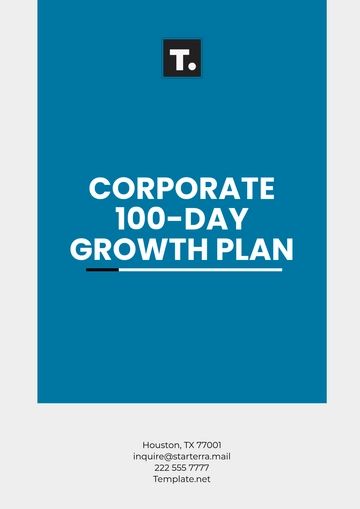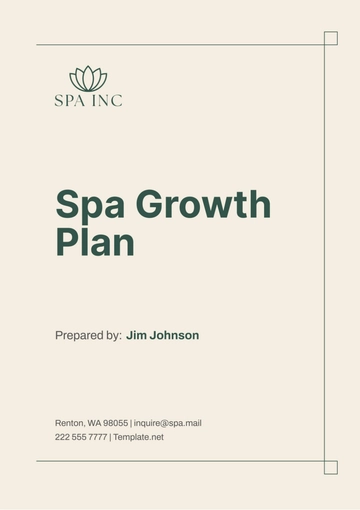Free Corporate 100-Day Growth Plan

Prepared by:
[Your Name]
[Your Company Name]
Overview
The Corporate 100-Day Growth Plan serves as a strategic framework for achieving immediate and impactful growth for [YOUR COMPANY NAME]. The plan provides a roadmap for senior leadership to drive measurable progress within the first 100 days. It focuses on aligning teams, improving processes, enhancing customer satisfaction, and setting the foundation for long-term success.
I. Objective of the 100-Day Growth Plan
The primary objective is to establish clear goals and actions that will drive performance and profitability while fostering a culture of collaboration and innovation. The plan will focus on the following core areas:
Leadership Alignment and Team Integration
Operational Efficiency and Process Optimization
Customer Engagement and Market Penetration
Financial Health and Performance Improvement
II. Key Goals and Milestones
1. Leadership Alignment and Team Integration (Days 1-30)
Establish Leadership Vision: Set clear expectations and communicate the company’s strategic vision with all senior executives and department heads. Hold town halls or team meetings to discuss the vision and gather feedback.
Evaluate Organizational Structure: Assess the current structure and identify any potential changes needed to improve efficiency. Address gaps in leadership or resources to ensure smooth integration and alignment.
Team Building and Communication: Initiate team-building exercises and improve cross-departmental communication. Create regular check-ins for key leaders to ensure cohesion across teams.
Engagement with Key Stakeholders: Meet with top clients, partners, and investors to build relationships and clarify the company’s goals and expectations.
2. Operational Efficiency and Process Optimization (Days 31-60)
Conduct Operational Audit: Analyze internal processes for inefficiencies. Identify areas where improvements can be made and create actionable plans for process optimization.
Implement Quick Wins: Implement simple, low-cost improvements that can drive immediate results, such as streamlining communication channels or eliminating redundant tasks.
Technology Upgrades: Review current technology and tools, identifying opportunities for automation, system upgrades, or new software that could improve productivity.
Optimize Supply Chain: Review vendor relationships and supply chain logistics to identify cost-saving opportunities or areas for greater efficiency.
3. Customer Engagement and Market Penetration (Days 61-90)
Customer Feedback and Research: Conduct surveys or focus groups to gather feedback from customers. Identify pain points and areas for improvement in products or services.
Launch Targeted Marketing Campaigns: Based on the customer feedback, implement targeted marketing initiatives to boost brand visibility, awareness, and engagement with key customer segments.
Strengthen Partnerships: Deepen relationships with current business partners and explore new partnership opportunities to drive growth and innovation.
Improve Customer Service: Invest in training for customer service teams to ensure they are equipped with the skills and knowledge to improve the customer experience.
4. Financial Health and Performance Improvement (Days 91-100)
Financial Review and Analysis: Conduct a comprehensive review of the company’s financials. Evaluate profitability, cash flow, and cost management practices.
Implement Cost-Cutting Measures: Identify areas where the company can reduce costs without compromising quality or customer satisfaction. This could include renegotiating contracts, reducing overhead, or consolidating resources.
Revenue Growth Strategy: Develop a revenue growth strategy, including new product offerings, market expansions, or pricing adjustments.
KPIs and Metrics: Establish key performance indicators (KPIs) to track progress on goals. Regularly review performance and adjust strategies as needed to meet targets.
III. Action Plan and Timeline
Objective | Action Steps | Responsible | Timeline |
|---|---|---|---|
Leadership Alignment and Team Integration | Communicate vision, evaluate structure | CEO, HR | Days 1-30 |
Operational Efficiency | Conduct audits, optimize processes | COO, Operations Team | Days 31-60 |
Customer Engagement and Market Penetration | Launch campaigns, enhance customer service | CMO, Customer Relations | Days 61-90 |
Financial Health | Review finances, implement cost-cutting | CFO, Finance Team | Days 91-100 |
IV. Success Metrics
To assess the effectiveness of the Corporate 100-Day Growth Plan, the following key performance indicators (KPIs) will be used:
Employee Engagement Score – Improved team alignment and communication as measured by employee surveys.
Customer Satisfaction Rating – Higher ratings in customer feedback surveys and reviews.
Revenue Growth – Increased revenue from new marketing efforts or product offerings.
Operational Efficiency – Reduced operational costs and time spent on non-essential tasks.
Financial Health – Improved profit margins and cash flow.
V. Review and Adjustments
At the end of the 100 days, a comprehensive review will be conducted to evaluate the outcomes based on the established KPIs. Adjustments will be made to the strategy based on the results, ensuring [YOUR COMPANY NAME] is positioned for sustained growth and success moving forward.
- 100% Customizable, free editor
- Access 1 Million+ Templates, photo’s & graphics
- Download or share as a template
- Click and replace photos, graphics, text, backgrounds
- Resize, crop, AI write & more
- Access advanced editor
The Corporate 100-Day Growth Plan Template from Template.net is a customizable and editable tool designed to drive business success. Fully editable in our Ai Editor Tool, this template allows you to personalize every aspect of your growth strategy, ensuring alignment with company goals. Streamline your planning process and set your business up for success.
You may also like
- Finance Plan
- Construction Plan
- Sales Plan
- Development Plan
- Career Plan
- Budget Plan
- HR Plan
- Education Plan
- Transition Plan
- Work Plan
- Training Plan
- Communication Plan
- Operation Plan
- Health And Safety Plan
- Strategy Plan
- Professional Development Plan
- Advertising Plan
- Risk Management Plan
- Restaurant Plan
- School Plan
- Nursing Home Patient Care Plan
- Nursing Care Plan
- Plan Event
- Startup Plan
- Social Media Plan
- Staffing Plan
- Annual Plan
- Content Plan
- Payment Plan
- Implementation Plan
- Hotel Plan
- Workout Plan
- Accounting Plan
- Campaign Plan
- Essay Plan
- 30 60 90 Day Plan
- Research Plan
- Recruitment Plan
- 90 Day Plan
- Quarterly Plan
- Emergency Plan
- 5 Year Plan
- Gym Plan
- Personal Plan
- IT and Software Plan
- Treatment Plan
- Real Estate Plan
- Law Firm Plan
- Healthcare Plan
- Improvement Plan
- Media Plan
- 5 Year Business Plan
- Learning Plan
- Marketing Campaign Plan
- Travel Agency Plan
- Cleaning Services Plan
- Interior Design Plan
- Performance Plan
- PR Plan
- Birth Plan
- Life Plan
- SEO Plan
- Disaster Recovery Plan
- Continuity Plan
- Launch Plan
- Legal Plan
- Behavior Plan
- Performance Improvement Plan
- Salon Plan
- Security Plan
- Security Management Plan
- Employee Development Plan
- Quality Plan
- Service Improvement Plan
- Growth Plan
- Incident Response Plan
- Basketball Plan
- Emergency Action Plan
- Product Launch Plan
- Spa Plan
- Employee Training Plan
- Data Analysis Plan
- Employee Action Plan
- Territory Plan
- Audit Plan
- Classroom Plan
- Activity Plan
- Parenting Plan
- Care Plan
- Project Execution Plan
- Exercise Plan
- Internship Plan
- Software Development Plan
- Continuous Improvement Plan
- Leave Plan
- 90 Day Sales Plan
- Advertising Agency Plan
- Employee Transition Plan
- Smart Action Plan
- Workplace Safety Plan
- Behavior Change Plan
- Contingency Plan
- Continuity of Operations Plan
- Health Plan
- Quality Control Plan
- Self Plan
- Sports Development Plan
- Change Management Plan
- Ecommerce Plan
- Personal Financial Plan
- Process Improvement Plan
- 30-60-90 Day Sales Plan
- Crisis Management Plan
- Engagement Plan
- Execution Plan
- Pandemic Plan
- Quality Assurance Plan
- Service Continuity Plan
- Agile Project Plan
- Fundraising Plan
- Job Transition Plan
- Asset Maintenance Plan
- Maintenance Plan
- Software Test Plan
- Staff Training and Development Plan
- 3 Year Plan
- Brand Activation Plan
- Release Plan
- Resource Plan
- Risk Mitigation Plan
- Teacher Plan
- 30 60 90 Day Plan for New Manager
- Food Safety Plan
- Food Truck Plan
- Hiring Plan
- Quality Management Plan
- Wellness Plan
- Behavior Intervention Plan
- Bonus Plan
- Investment Plan
- Maternity Leave Plan
- Pandemic Response Plan
- Succession Planning
- Coaching Plan
- Configuration Management Plan
- Remote Work Plan
- Self Care Plan
- Teaching Plan
- 100-Day Plan
- HACCP Plan
- Student Plan
- Sustainability Plan
- 30 60 90 Day Plan for Interview
- Access Plan
- Site Specific Safety Plan










